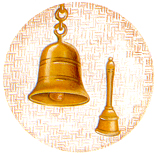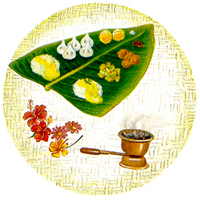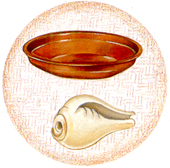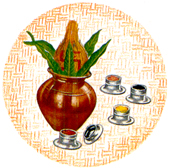 |
|
Bells
of various shapes are used in worship. The ringing of
bells in a temple of church is a call to pray and surrender
to divinity.
|
|
Panchapatri
- a mini drum-like beaker which holds water or milk and is used with
the achamani. The walls of this container are decorated with various
motifs in copper and silver. Both the panchapatri and achamani can
be made of silver.
Ghanta - a bell made of brass,
copper or silver is used during rituals or while singing aartis.
Kalash - a full pot on which a
coconut and a sprig of mango leaves is placed, is a popular representation
of god.
Tamhan -
a metal platter to receive the water used during rituals is part of
the rites of worship.
Shankh - a large conch shell is
worshipped as a symbol of Vishnu. It is blown at rituals to propitiate
god.
Prasad -
cooked food offered to god is called Pacca Khana and cannot contain
onions and garlic.
In most homes and temples, this is strictly vegetarian food.
Panchamrit, used for ritual baths of deities, is made by mixing equal
parts of milk, yoghurt, sugar, honey and ghee. Fruits, dryfruits or
cooked food offered to god is known as naivedya and when distributed
to devotees is called prasad. Holy water distributed at a puja is
called tirth.
 |
|
Prasad
is offered as blessed food. Flowers and incense are widely
used for decoration in rituals.
|
|
Phool
- each deity also has its own favourite flower. For rituals, blooms
are chosen for their colour, fragrance and beauty. Leaves of various
trees and plants which are considered holy are also used. Garlands
are made in innumerable designs and torans decorate doors of homes
or temples on festive days.
Dhoop - attar, joss sticks or
agarbattis, camphor, sandalwood paste and saffron are used extensively
in worship both as an offering as well as to create a sweet atmosphere.
 |
|
Shankh
or a conch, is blown at auspicious moments. Its sound
is symbolic of the divine power to destroy evil.
|
|
Other puja materials
- kumkum (vermilion), haldi (turmeric),
sindoor (lead oxide), abir and gulal are used for annointing the deities.
Holy rice or akshata, is made by mixing rice, kumkum and a little
water. Coconuts, betel leaves and nuts are offered both to god and
to honoured guests at festive worship. Rangoli designs in predetermined
and often intricate patterns and colours are drawn for specific puja
rituals.
 |
|
Embellishments
of worship are used for creating beauty and serenity
|
|



